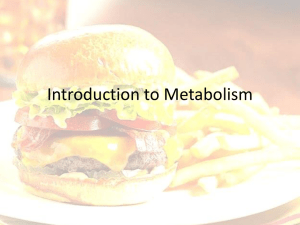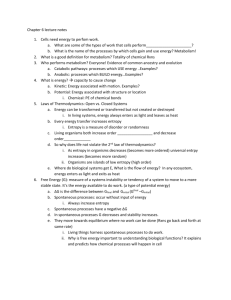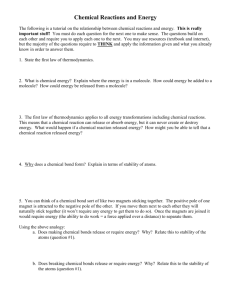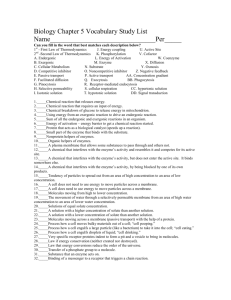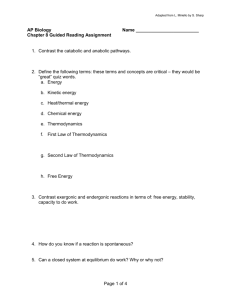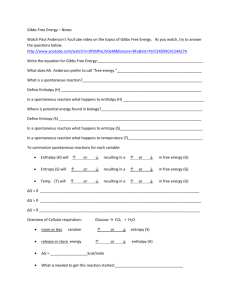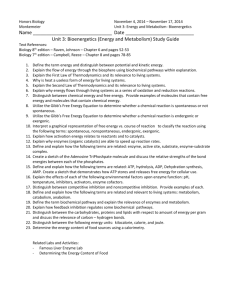AP BIOLOGY Chapter 8 Metabolism
advertisement
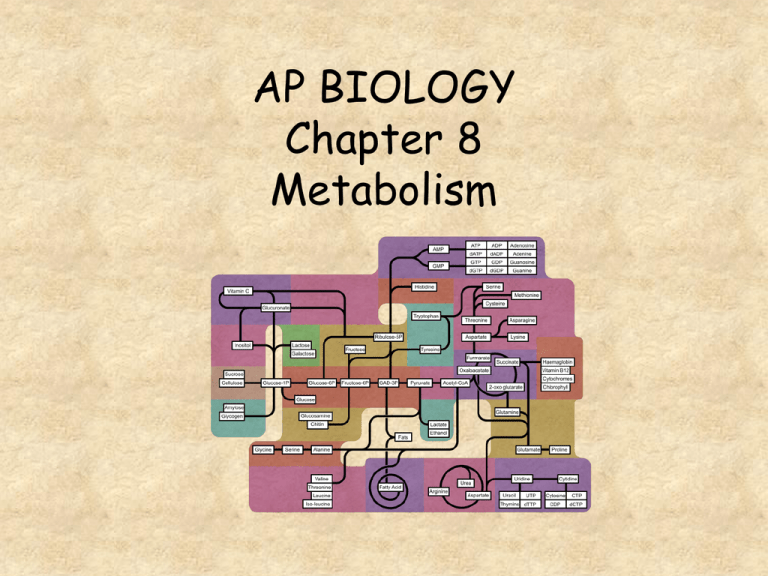
AP BIOLOGY Chapter 8 Metabolism The FIRST _____ Law of Thermodynamics states that energy can be transformed and transferred by NEVER created or destroyed Anabolic pathways → consume energy to build molecules release energy by breaking down molecules The measure of disorder or randomness (symbolized by S) entropy The SECOND _______ Law of Thermodynamics states that every energy transfer or transformation increases the entropy of the universe. Chemical reactions with a NEGATIVE free energy (- Δ G) are ____________ exergonic endergonic exergonic Chemical reactions with a POSITIVE endergonic free energy (+ Δ G) are ____________ endergonic exergonic Most enzymes belong to which group of macromolecules? proteins Molecules that speed up chemical catalysts reactions are called ____________ Energy associated with moving objects is called _______ kinetic energy Catabolic pathways consume energy to build molecules → release energy by breaking down molecules potential Chemical energy is a form of ___________ energy kinetic potential Reactions that release free energy exergonic are called ______________ exergonic endergonic negative The hydrolysis of ATP is a ________ ΔG reaction. Catalytic proteins that speed up chemical reactions in living things are called enzymes ____________ Reactions that absorb free energy endergonic are called ______________ exergonic endergonic Chemical reactions with a NEGATIVE free energy (- Δ G) are ____________ spontaneous spontaneous nonspontaneous Region on an enzyme where regulatory Allosteric site molecules can bind = ______________ Chemical reactions with a POSITIVE nonspontaneous free energy (+ Δ G) are ____________ spontaneous nonspontaneous The initial investment of energy for starting a chemical reaction is called Activation energy OR the _______________ Energy of activation The place on an enzyme where the active site substrate attaches = _____________ Chemical reactions with a NEGATIVE spontaneous free energy (- Δ G) are ____________ spontaneous nonspontaneous Which kinds of bonds hold the substrate to the active site of an enzyme? Weak interactions like hydrogen & ionic bonds Nonprotein “helpers” for catalytic activty cofactors are called ______________ If a cofactor is an organic molecule it coenzyme is called a ____________ Which kind of food molecules often act as coenzymes? vitamins A molecule that mimics a substrate, binds to the active site, and reduces the activity of an enzyme is called COMPETITIVE a(n) _______________ inhibitor. NONCOMPETITIVE inhibitors slow down ______________ enzymatic reactions by binding to a site other than the active site and causing a change in the enzyme’s shape FEEDBACK In ___________ inhibition, a metabolic pathway is switched off by the binding of its end product. The change in the shape of the active site of an enzyme after the substrate attaches so that it binds more snugly INDUCED FIT is called _____________ When the binding of one substrate molecule primes an enzyme to accept additional substrate molecules more readily it is called COOPERATIVITY ______________ The arrow in the diagram is showing ACTIVATION ENERGY of this the _________________ reaction. The arrow in the diagram is showing CHANGE IN FREE ENERGY (ΔG) of the ______________________ this reaction. + Δ G because This reaction has a ___ the energy of the products is greater then the reactants - This reaction has a ___ Δ G because the energy of the products is less then the reactants How would adding an enzyme change the graph of this reaction? Enzymes lower the activation energy of chemical reactions but don’t change the energy of the products Cells manage their energy resources by using the energy from exergonic (-ΔG) reactions to drive endergonic (+ΔG) reactions in a process called Energy coupling ____________________ ADP + Pi → ATP + This is a __ ΔG reaction. Cellular respiration uses glucose, which has a high level of free energy and releases CO2 and H2O which have low levels of free energy. Is respiration spontaneous or not? spontaneous Is it exergonic or endergonic? exergonic How does the 2nd LAW of thermodynamics help explain the diffusion of a substance across a membrane? The 2nd Law is the tendency toward randomness. Having equal concentrations on both sides of a membrane is more random than unequal concentrations. Diffusion from high concentration to low INCREASES THE ENTROPY as mandated by the 2nd law If living things take simpler substances and build them into complicated systems (increase entropy), why does this NOT VIOLATE the 2nd LAW of thermodynamics ? Living things are OPEN systems and must constantly take in energy and materials from outside to maintain the increase in entropy
